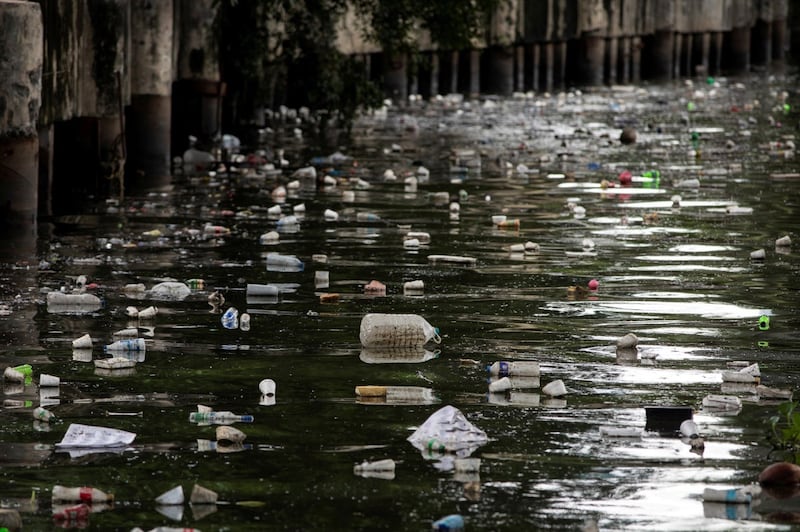Trillions of small bits of plastic are floating on the world's oceans due to a rapid and unprecedented increase in the last two decades, scientists said in a new study released on Wednesday.
Calling it “a growing plastic smog,” the researchers said the rate of plastic entering the oceans could accelerate 2.6 times by 2040 if left without widespread policy changes.
The research, published in the PLOS ONE journal, estimated that between 82 trillion and 358 trillion plastic particles – primarily microplastics – were floating on the ocean’s surface in 2019.
The total amount would weigh between 1.1 million tons and 4.9 million tons, according to the analysis from a global dataset of ocean plastic pollution between 1979 and 2019.
“We observed no clear trend until 1990, followed by a fluctuating but stagnant trend until 2005 and a rapid increase thereafter,” the study said. “This acceleration of plastic densities in the world’s oceans, also observed in beaches worldwide, necessitates immediate international policy interventions.”
Marcus Eriksen, the study’s co-author, said in a statement that he was alarmed by the “trend of exponential growth of microplastics in the global ocean.”
“This is a stark warning that we must act now at a global scale. We need a strong, legally binding UN Global Treaty on plastic pollution that stops the problem at the source,” he said.
The study analyzed data on plastic pollution at the ocean surface level from 11,777 stations across six marine regions (North Atlantic, South Atlantic, North Pacific, South Pacific, Indian and Mediterranean).
The significant and rapid increase in the global ocean abundance and distribution of plastics in the ocean surface layer since 2005 is reflective of the worldwide growth in plastic production and waste generation, the researchers said.
The report also cites a lack of adequate plastic recycling worldwide, which “has resulted in a flood of plastic products and packaging” that remain as mismanaged waste in the receiving country. Another factor is an increased amount of plastic waste from “large fishing fleets and artisanal fisheries.”
“Some of this pollution is due to our consumer choices: every piece of plastic we dispose of has the potential to escape from waste streams and enter our oceans, where it fragments into countless microplastics that harm marine life,” said Charlene Trestrail, an Australian ecotoxicologist who was not involved in the study.
Plastic pollution and Southeast Asia
Wednesday's study did not contain regional breakdown. However, according to a 2021 study six Southeast Asian countries are among the top 10 nations producing the highest amount of ocean plastic waste annually.
The researchers of that study published in the Science Advances journal estimated that some 1,000 rivers accounted for 80 percent of global annual emissions, with small urban rivers among the most polluting.
The Philippines is estimated to account for 35 percent of the total plastic waste in the ocean. The archipelago country, with more than 7,000 islands, produces 356,371 metric tons of plastic waste in the sea each year, the study said.

In fact, 75 percent of the plastic accumulated in the ocean comes from mismanaged waste in Asian countries, which include India, Malaysia, China, Indonesia, Myanmar, Vietnam, Bangladesh, Thailand and the Philippines. Brazil was the only non-Asian country in the top 10.
In 2021, the Association of Southeast Asian Nations launched a regional action plan to combat marine plastic debris with the World Bank’s $20 million fund.
“The volume of solid waste and marine debris generated across Southeast Asia is on the rise. Coupled with expanding urbanization and a growing consuming class, the long-term effects are only just emerging,” Thailand’s Environment Minister Varawut Silpa-archa, said at the time.
If the problem is not addressed, the amount of plastic entering marine environments could increase tenfold by 2025, he added.
Plastic is estimated to account for 80 percent of all marine debris in the oceans, according to the International Union for the Conservation of Nature.
Their 2017 report found that 95 percent of the plastic in the ocean originates from the land through rainwater and river systems and from maritime activities such as fishing and shipping.
According to the OECD, less than 10 percent of plastic waste is recycled, which predicts that global plastic waste will increase by almost three times from 460 million tons in 2019 to 1,231 million tons in 2060.
Problem much bigger than previously thought
Applied chemist Amy Heffernan said the latest estimate “is the equivalent of 500,000 elephants floating in our oceans worldwide.”
The findings “suggest that there is much more plastic pollution floating in the oceans than we previously thought,” Trestrail added, which “means that we have been underestimating the scale of marine plastic pollution.”
Paul Harvey, an environmental public health scientist, also said the “numbers in this new research are staggeringly phenomenal and almost beyond comprehension.”
“The mind boggles imagining what 4.9 million tons of plastic would look like. Globally, we have reached a point where we can no longer ignore the plastic pollution pandemic that is infecting our oceans,” said Harvey, who was not involved in the study.
He said the beach clean-ups and similar citizen environment projects on plastics “have little impact on solving the enormity of the plastic problem.”
“Solutions that are applied across the material lifecycle are the only way to solve the plastic pollution crisis and prevent more loss to the environment,” he said.
Last year, delegates from around 160 nations met in Uruguay for the first-ever United Nations-led plastics treaty negotiations, which ended an agreement to end plastic pollution.
However, they could not agree on whether the efforts should be global and mandatory or voluntary and country-led.
On Saturday night, some 193 countries agreed to an ambitious United Nations treaty to protect ocean life by establishing protected areas in international waters. It comes as ocean life faces growing threats from climate change, overfishing, shipping traffic and seabed mining on the high seas.
Edited by Matt Reed.
